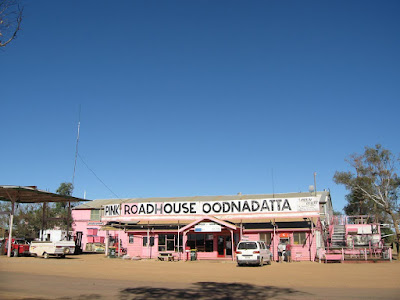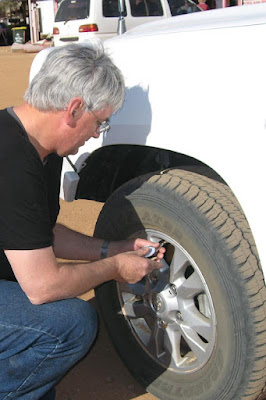 Just north of Alice Springs we crossed the Tropic of Capricorn - so now it is official - we have gone "Troppo"
Just north of Alice Springs we crossed the Tropic of Capricorn - so now it is official - we have gone "Troppo" The Stuart Highway was a dirt track until WW2 when the need to move troops and goods back and forth from Alice Springs where the Ghan terminated meant the track deteriorated badly under constant traffic and the road was bitumenised. All the States Public works departments were assigned a section.
 Shortly after we stopped to move a dead Kangaroo further from the road to help protect the Wedge Tail Eagles which are killed in increasing numbers as they rise into the path of cars after feeding on the carcass.
Shortly after we stopped to move a dead Kangaroo further from the road to help protect the Wedge Tail Eagles which are killed in increasing numbers as they rise into the path of cars after feeding on the carcass. 
We stopped for coffee at the Aileron station roadhouse and admired the aboriginal art and the huge [12 meters high] sculptures of the Anmatjere man, woman and child and Hollywood style sign erected by the Alice Springs sculptor Mark Egan.
We then passed the marker for Central Mount Stuart which Stuart calculated as the point equidistant from North, South, East and West coasts and thus in his view the centre of Australia.

 At Barrow Creek there is a well preserved Overland Telegraph repeater station. It gives a sense of the isolation and scale of undertaking to construct the line in the space of two years less than ten years after the country was first explored. It was an amazing technological feat to connect Australia to the rest of the world in that era and through that rugged country.
At Barrow Creek there is a well preserved Overland Telegraph repeater station. It gives a sense of the isolation and scale of undertaking to construct the line in the space of two years less than ten years after the country was first explored. It was an amazing technological feat to connect Australia to the rest of the world in that era and through that rugged country. 
 Our overnight stop was at Wycliffe Wells the unofficial UFO Capital of Australia. Unfortunately no luck in seeing a flying saucer. However we drove to watch the sunset at the Devils Marbles which was wonderful.
Our overnight stop was at Wycliffe Wells the unofficial UFO Capital of Australia. Unfortunately no luck in seeing a flying saucer. However we drove to watch the sunset at the Devils Marbles which was wonderful.  From Wycliffe Wells we drove to Tennant Creek, a town which arose from a 1930's gold rush. At Tennant Creek we saw the Battery Hill Mine and the Old Telegraph Office.
From Wycliffe Wells we drove to Tennant Creek, a town which arose from a 1930's gold rush. At Tennant Creek we saw the Battery Hill Mine and the Old Telegraph Office. 
There is a great social history display which shows how hard it was to be a miner and miners family in such a remote mining town where initially the water had to be shipped in 44 gallon drums.
 Outside Tennant Creek we came to the Three Ways, the intersection of the Stuart and Barkly Highways and the site of another memorial to the Rev John Flynn.
Outside Tennant Creek we came to the Three Ways, the intersection of the Stuart and Barkly Highways and the site of another memorial to the Rev John Flynn. 
 We then detoured to Newcastle Waters, the junction of the North South Murranji and East West Barkly stock routes from the days when drovers moved cattle to the seaboard markets. It had a Stockman's Memorial and the Junction Hotel built for "free" by a group of the hoteliers creditors out of disused windmills on stock bores.
We then detoured to Newcastle Waters, the junction of the North South Murranji and East West Barkly stock routes from the days when drovers moved cattle to the seaboard markets. It had a Stockman's Memorial and the Junction Hotel built for "free" by a group of the hoteliers creditors out of disused windmills on stock bores.  There is also an AIM Church built from a Sydney Williams Hut or Comet hut. These were used to house the troops during WW2
There is also an AIM Church built from a Sydney Williams Hut or Comet hut. These were used to house the troops during WW2  From there we drove to Daly Waters. This has an historic pub and serves a great Barra and Beef Barbecue.
From there we drove to Daly Waters. This has an historic pub and serves a great Barra and Beef Barbecue. It has Australia's most remote traffic light - always red and always ignored, but fortunately no sign of Australia's most remote traffic policeman.

 Daly Waters is also the site of Australia's first International Airport and the hangars and terminal remain. It is also the site of what remains of an "S" carved by Stuart on a tree nearby, almost impossible to see and impossible to photograph.
Daly Waters is also the site of Australia's first International Airport and the hangars and terminal remain. It is also the site of what remains of an "S" carved by Stuart on a tree nearby, almost impossible to see and impossible to photograph.  From Daly Waters we drove to Katherine, stopping for lunch at Mataranka to see the "Big Termite" mound and swim at the Mataranka Springs [created by soldiers in WWII without the need for an Environmental Impact Statement] and then at the naturally occurring Bitter Springs.
From Daly Waters we drove to Katherine, stopping for lunch at Mataranka to see the "Big Termite" mound and swim at the Mataranka Springs [created by soldiers in WWII without the need for an Environmental Impact Statement] and then at the naturally occurring Bitter Springs. Bitter Springs is in Elsey National Park.
Mataranka is where the Elsey Homestead was located. Mrs. Aeneas Gunn wrote ' We of the Never Never' and 'Little Black Princess' about her experiences here.
Never never means never never go there or never never leave depending on your point of view.



















































![NEW - THE MAPS [By Popular Request]](https://blogger.googleusercontent.com/img/b/R29vZ2xl/AVvXsEjHG1GHJCw30W7yaMbn9QB-NguxDm0UBxGPEy7qV7lsrcEFPKm_7fcurfCO47uI3fax5yInPaNuygFhPiaX-CHlS1KO26YGmjK7qIz5SLChr-2LGgdriqpA-L1PDtyBBjD0WBPltishqpo/s187/Around+Australia.jpg)